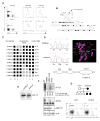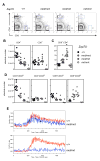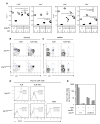Opposing functions of the T cell receptor kinase ZAP-70 in immunity and tolerance differentially titrate in response to nucleotide substitutions
- PMID: 18093540
- PMCID: PMC3163119
- DOI: 10.1016/j.immuni.2007.11.013
Opposing functions of the T cell receptor kinase ZAP-70 in immunity and tolerance differentially titrate in response to nucleotide substitutions
Abstract
Null mutations that cripple T cell receptor (TCR) signaling explain rare primary immunodeficiencies, but it is not understood why more common polymorphisms that lead to subtle TCR signaling defects are paradoxically associated with autoimmunity. Here we analyzed how a series of Zap70 variants with step-wise decreases in TCR signaling impacted upon opposing TCR functions of immunity and tolerance. One Zap70 variant, murdock, moderately decreased TCR signaling and thymic selection without compromising immunological tolerance, whereas a more severe Zap70 defect, mrtless, abolished thymic-positive selection and led to immunodeficiency. Signaling capacities between these two thresholds disproportionately compromised negative selection and Foxp3(+) regulatory T cell formation, creating a cellular imbalance between immunogenic and tolerogenic functions that resulted in the excessive production of autoantibodies and immunoglobulin E (IgE). The pleiotropic functions of ZAP-70 and their differential response to graded variation provide a paradigm for understanding the complex outcomes of human genetic variation.
Conflict of interest statement
The authors declare that they have no competing financial interests.
Figures







References
-
- Aguado E, Richelme S, Nunez-Cruz S, Miazek A, Mura AM, Richelme M, Guo XJ, Sainty D, He HT, Malissen B, Malissen M. Induction of T helper type 2 immunity by a point mutation in the LAT adaptor. Science. 2002;296:2036–2040. - PubMed
-
- Akkaraju S, Ho WY, Leong D, Canaan K, Davis MM, Goodnow CC. A range of CD4 T cell tolerance: partial inactivation to organ-specific antigen allows nondestructive thyroiditis or insulitis. Immunity. 1997;7:255–271. - PubMed
-
- Arkwright PD, Abinun M, Cant AJ. Autoimmunity in human primary immunodeficiency diseases. Blood. 2002;99:2694–2702. - PubMed
-
- Arpaia E, Shahar M, Dadi H, Cohen A, Roifman CM. Defective T cell receptor signaling and CD8+ thymic selection in humans lacking zap-70 kinase. Cell. 1994;76:947–958. - PubMed
Publication types
MeSH terms
Substances
Grants and funding
LinkOut - more resources
Full Text Sources
Molecular Biology Databases
Research Materials

